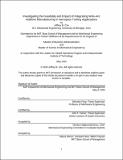Investigating the feasibility and impact of integrating wire-arc additive manufacturing in aerospace tooling applications
Author(s)
Chu, Jeffrey B.(Jeffrey Bowen)
Download1191622757-MIT.pdf (1.743Mb)
Other Contributors
Sloan School of Management.
Massachusetts Institute of Technology. Department of Mechanical Engineering.
Leaders for Global Operations Program.
Advisor
Nicholas Fang and John F. Carrier.
Terms of use
Metadata
Show full item recordAbstract
The use of wire-arc additive manufacturing (WAAM) as fabrication method for Iron-Nickel 36 (Invar36) alloy aerospace tooling is a growing area of interest for many tooling companies and composite aircraft manufacturers. However, the full adoption and utilization of WAAM techniques is hindered due to lack of industry experience and end-part quality precedent. For some tool makers, the feasibility of utilizing additively manufactured Invar components is still under investigation because key material characteristics of end-parts are not well understood. Further, the impact of implementing additive manufacturing on a manufacturer's internal operations is not widely documented. While much academic research has been conducted on WAAM technologies, Invar, and change management for new technology introductions, much of the available literature does not provide the specificity needed to supplant an aerospace toolmakers' need for hands-on experience. This research will investigate both the technical feasibility of using WAAM Invar components (with respect to end-part quality and performance) in aerospace tool fabrication, as well as the organizational feasibility and impact of adopting the technology. This thesis will describe the series of testing completed to evaluate WAAM Invar in the context of an aerospace toolmaker and will outline some of the key organizational impacts that must be acknowledged for adoption of additive manufacturing within an aerospace tool making company. Because of this research, we hope to demonstrate the viability of utilizing WAAM Invar for aerospace tooling applications.
Description
Thesis: M.B.A., Massachusetts Institute of Technology, Sloan School of Management, in conjunction with the Leaders for Global Operations Program at MIT, May, 2020 Thesis: S.M., Massachusetts Institute of Technology, Department of Mechanical Engineering, in conjunction with the Leaders for Global Operations Program at MIT, May, 2020 Cataloged from the official PDF of thesis. Includes bibliographical references (pages 65-67).
Date issued
2020Department
Sloan School of Management; Massachusetts Institute of Technology. Department of Mechanical Engineering; Leaders for Global Operations ProgramPublisher
Massachusetts Institute of Technology
Keywords
Sloan School of Management., Mechanical Engineering., Leaders for Global Operations Program.